
|
Now it is 7.4 mag (Feb. 3, Juan Jose Gonzalez). It was expected to brighten up to 4-5 mag from autumn to winter. But actually, it was 6 mag at best. It will be fading rapidly after this. It is observable in excellent condition in the Northern Hemisphere. It is not observable after this in the Southern Hemisphere.
Date(TT) R.A. (2000) Decl. Delta r Elong. m1 Best Time(A, h)
Feb. 6 5 34.32 77 16.0 0.997 1.652 112 7.9 20:37 (179,-22)
Feb. 13 4 32.73 69 52.9 1.179 1.746 107 8.5 20:28 (172,-16)
|

|
Now it is very bright as 8.5 mag (Feb. 3, Juan Jose Gonzalez). It brightened temporarily in outburst in early January, but it returned to the original brightness. It will pass close to the earth from spring to summer, and it is expected to brighten up to 5-6 mag. In the Northern Hemisphere, it will be unobservable in late February. It will appear in the morning sky again in late April, but it locates low in the south around the high light. In the Southern Hemisphere, it is not observable now. But after appearing in the morning sky again in mid April, it will be observable in excellent condition.
Date(TT) R.A. (2000) Decl. Delta r Elong. m1 Best Time(A, h)
Feb. 6 23 37.83 10 39.9 2.273 1.710 44 8.7 20:37 ( 98, -7)
Feb. 13 23 36.36 9 23.5 2.337 1.649 36 8.6 20:28 ( 94,-10)
|

|
Now it is so bright as 9.2 mag (Feb. 3, Juan Jose Gonzalez). It is observable at 9-10 mag until spring in excellent condition in the Northern Hemisphere. It keeps unobservable in the Southern Hemisphere.
Date(TT) R.A. (2000) Decl. Delta r Elong. m1 Best Time(A, h)
Feb. 6 16 30.44 66 39.0 1.853 2.209 97 9.2 3:49 (200,-20)
Feb. 13 16 12.29 68 12.6 1.841 2.235 100 9.4 3:58 (195,-18)
|
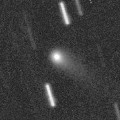
|
Now it is bright as 12.4 mag (Jan. 9, Seiichi Yoshida). It keeps 12 mag for a long time from 2015 autumn to 2016 summer. In the Northern Hemispehre, it keeps observable in good condition for a long time. It keeps unobservable in the Southern Hemisphere.
Date(TT) R.A. (2000) Decl. Delta r Elong. m1 Best Time(A, h)
Feb. 6 20 18.02 65 25.5 2.646 2.693 82 12.1 3:49 (210,-40)
Feb. 13 20 23.96 64 56.2 2.673 2.685 80 12.1 3:58 (211,-37)
|

|
Now it is 13.6 mag (Jan. 29, Sandor Szabo). It will brighten up to 11 mag from spring to summer. In the Northern Hemisphere, it keeps observable in good condition while the comet will be brightening. It locates somewhat low in the Southern Hemisphere.
Date(TT) R.A. (2000) Decl. Delta r Elong. m1 Best Time(A, h)
Feb. 6 5 1.56 19 57.3 1.559 2.221 119 13.1 20:37 (169, 34)
Feb. 13 5 2.49 20 13.9 1.597 2.181 113 13.0 20:28 (164, 33)
|
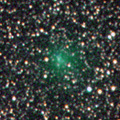
|
Now it is 11.8 mag (Jan. 8, Giuseppe Pappa). It keeps 11-13 mag until February. But it keeps very low.
Date(TT) R.A. (2000) Decl. Delta r Elong. m1 Best Time(A, h)
Feb. 6 23 30.08 -11 42.2 2.398 1.660 32 13.1 20:37 ( 79, 5)
Feb. 13 23 49.20 -9 47.5 2.463 1.696 31 13.3 20:28 ( 81, 4)
|
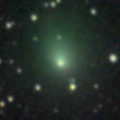
|
It is not observable now. It will appear in the morning sky in June. But the comet will be faint as 16-17 mag.
Date(TT) R.A. (2000) Decl. Delta r Elong. m1 Best Time(A, h)
Feb. 6 22 22.10 -12 23.7 2.790 1.866 16 13.2 20:37 ( 69, -8)
Feb. 13 22 39.31 -10 51.4 2.846 1.903 13 13.4 20:28 ( 70,-10)
|
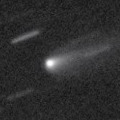
|
Now it is 13.3 mag (Jan. 9, Seiichi Yoshida). It will brighten up to 13 mag from winter to spring. It will be observable in excellent condition in the Southern Hemisphere. But it locates somewhat low in the Northern Hemisphere.
Date(TT) R.A. (2000) Decl. Delta r Elong. m1 Best Time(A, h)
Feb. 6 15 10.09 -17 54.0 2.024 2.195 86 13.6 3:49 (250, 55)
Feb. 13 15 20.05 -18 43.9 1.948 2.199 90 13.5 3:58 (244, 60)
|

|
It brightened up to 3.7 mag and became a naked eye comet in mid January in 2015 (Jan. 13, Marek Biely). Now it is fading. It has already faded down to 14.6 mag (Jan. 26, Ken-ichi Kadota). In the Northern Hemisphere, it keeps observable for a long time until the comet fades out. It is not observable until March in the Southern Hemisphere.
Date(TT) R.A. (2000) Decl. Delta r Elong. m1 Best Time(A, h)
Feb. 6 18 17.10 20 27.8 5.192 4.727 56 13.7 3:49 (249, -5)
Feb. 13 18 20.96 20 46.6 5.202 4.793 60 13.8 3:58 (244, 1)
|

|
Appearing in the morning sky in the Southern Hemisphere. It will be observable soon also in the Northern Hemisphere.
Date(TT) R.A. (2000) Decl. Delta r Elong. m1 Best Time(A, h)
Feb. 6 19 9.84 -26 51.6 6.788 5.966 31 14.0 3:49 (295, 11)
Feb. 13 19 15.52 -26 40.9 6.724 5.964 36 14.0 3:58 (291, 17)
|

|
It brightened up to 11.1 mag in 2015 autumn (Sept. 21, Seiichi Yoshida). Now it is 14.0 mag (Jan. 24, Ken-ichi Kadota). It keeps observable in good condition after this, while the comet will be fading gradually.
Date(TT) R.A. (2000) Decl. Delta r Elong. m1 Best Time(A, h)
Feb. 6 12 18.58 8 54.2 1.492 2.297 134 14.6 3:18 (180, 46)
Feb. 13 12 13.66 9 35.6 1.485 2.350 142 14.7 2:45 (180, 46)
|

|
Now it is 14.8 mag (Nov. 22, Catalina Sky Survey). Distant object, but it keeps observable at 14-15 mag for a long time from 2015 to 2016. It becomes unobservable temporarily from January to March in the Southern Hemisphere, or from February to April in the Northern Hemisphere.
Date(TT) R.A. (2000) Decl. Delta r Elong. m1 Best Time(A, h)
Feb. 6 22 29.29 -5 38.2 5.858 4.949 20 14.8 20:37 ( 75,-11)
Feb. 13 22 36.40 -5 12.0 5.885 4.941 15 14.8 20:28 ( 74,-14)
|
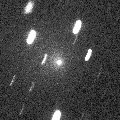
|
It passed near by the earth and brightened up to 12.1 mag from mid December to early January (Dec. 20, Thomas Lehmann). Now it is 13 mag (Jan. 26, Giuseppe Pappa). It is observable in excellent condition in the Northern Hemisphere. However, it will be fading rapidly after this. It is not observable in the Southern Hemisphere.
Date(TT) R.A. (2000) Decl. Delta r Elong. m1 Best Time(A, h)
Feb. 6 3 1.96 50 55.4 1.500 1.936 100 14.9 20:37 (156, -3)
Feb. 13 2 57.17 47 0.7 1.710 2.009 92 15.4 20:28 (151, -2)
|
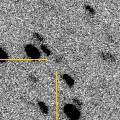
|
Current brightness is uncertain. It is expected to brighten very rapidly and reach up to 11 mag in March. In this apparition, it keeps observable in excellent condition both brightening and fading period. In the Northern Hemisphere, it will be unobservable temporarily in mid March.
Date(TT) R.A. (2000) Decl. Delta r Elong. m1 Best Time(A, h)
Feb. 6 5 57.30 -21 45.8 0.254 1.129 118 15.5 20:53 (180, 77)
Feb. 13 5 51.67 -23 57.6 0.218 1.088 112 15.1 20:28 (170, 79)
|

|
It kept brightening even after the perihelion passage, and brightened up to 13.0 mag (Dec. 21, Juan Jose Gonzalez). It keeps observable in excellent condition for a while. But it will be fading after this. It has already faded down to 15.4 mag (Jan. 29, Sandor Szabo).
Date(TT) R.A. (2000) Decl. Delta r Elong. m1 Best Time(A, h)
Feb. 6 5 30.94 22 33.2 0.915 1.701 126 15.1 20:37 (177, 32)
Feb. 13 5 40.41 24 15.7 0.996 1.735 122 15.4 20:28 (175, 30)
|
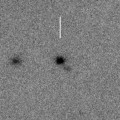
|
Now it is 17.9 mag (Jan. 19, Ken-ichi Kadota). It will be observable at 11 mag in good condition from spring to summer. It is much fainter than this ephemeris recently. But it will start brightening rapidly soon.
Date(TT) R.A. (2000) Decl. Delta r Elong. m1 Best Time(A, h)
Feb. 6 12 28.64 14 47.4 1.442 2.239 133 15.5 3:28 (180, 40)
Feb. 13 12 29.76 15 31.0 1.350 2.198 139 15.2 3:01 (180, 40)
|
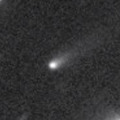
|
Now it is 16.7 mag (Dec. 11, D. Buczynski). It is observable at 14-15 mag in good condition from winter to summer.
Date(TT) R.A. (2000) Decl. Delta r Elong. m1 Best Time(A, h)
Feb. 6 13 41.30 -2 38.1 1.879 2.424 111 15.6 3:49 (203, 56)
Feb. 13 13 43.39 -3 41.9 1.786 2.412 117 15.4 3:58 (188, 59)
|
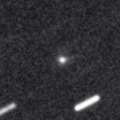
|
Appearing in the morning sky. It will be observable at 14 mag in good condition from spring to summer.
Date(TT) R.A. (2000) Decl. Delta r Elong. m1 Best Time(A, h)
Feb. 6 18 10.31 -18 21.1 3.136 2.524 44 15.5 3:49 (280, 18)
Feb. 13 18 24.24 -18 13.5 3.062 2.509 47 15.4 3:58 (277, 23)
|
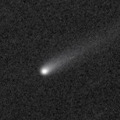
|
It brightened very rapidly in 2015 spring, and reached up to 13.8 mag (May 11, Sandor Szabo). It is bright as 14.8 mag still now (Jan. 24, Ken-ichi Kadota). It keeps 15 mag for a while until spring. It is observable in excellent condition in the Southern Hemisphere. But it locates somewhat low in the Northern Hemisphere.
Date(TT) R.A. (2000) Decl. Delta r Elong. m1 Best Time(A, h)
Feb. 6 14 10.80 -27 34.7 3.600 3.836 96 15.5 3:49 (252, 71)
Feb. 13 14 13.41 -28 12.0 3.524 3.859 102 15.5 3:58 (239, 78)
|

|
Now it is 15.7 mag (Dec. 19, Y. Sugiyama). It keeps 15-16 mag for a long time until 2016. It keeps observable in excellent condition in the Northern Hemisphere. It keeps unobservable in the Southern Hemisphere.
Date(TT) R.A. (2000) Decl. Delta r Elong. m1 Best Time(A, h)
Feb. 6 2 42.21 73 2.7 4.959 5.266 102 15.7 20:37 (167,-22)
Feb. 13 2 42.98 72 44.6 5.035 5.275 98 15.7 20:28 (166,-23)
|

|
First return of an object discovered as an asteroid 2007 VA85 in 2007. Faint tail was observed on Jan. 8 by Hidetaka Sato. Now it is 17.2 mag (Jan. 10, E. Bryssinck). It will approach to the earth down to 0.5 a.u., will brighten up to 15-16 mag, and will be observable in excellent condition.
Date(TT) R.A. (2000) Decl. Delta r Elong. m1 Best Time(A, h)
Feb. 6 7 51.30 -40 56.6 0.574 1.366 119 16.0 22:39 ( 0, 85)
Feb. 13 6 22.43 -25 37.9 0.527 1.315 117 15.8 20:45 (180, 79)
|
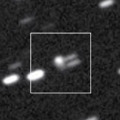
|
Now it is 16.4 mag (Jan. 15, Thomas Lehmann). It is expected to brighten up to 7 mag in 2017 summer. In the Northern Hemisphere, it keeps observable in good condition until the highlight while the comet will be brightening. In the Southern Hemisphere, it is not observable until early 2017.
Date(TT) R.A. (2000) Decl. Delta r Elong. m1 Best Time(A, h)
Feb. 6 7 9.78 64 11.9 5.026 5.677 127 16.0 22:06 (180, -9)
Feb. 13 7 2.02 64 5.6 5.024 5.616 122 16.0 21:31 (180, -9)
|

|
Now it is 15.8 mag (Dec. 7, Yuji Ohshima). In the Northern Hemisphere, it keeps observable after this while the comet will be fading. It will be getting higher gradually after this also in the Southern Hemisphere.
Date(TT) R.A. (2000) Decl. Delta r Elong. m1 Best Time(A, h)
Feb. 6 14 23.31 23 52.9 2.375 2.839 108 16.1 3:49 (204, 27)
Feb. 13 14 23.85 24 51.0 2.347 2.886 113 16.2 3:58 (195, 29)
|
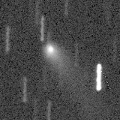
|
Now it is 15.3 mag (Dec. 13, D. Buczynski). It kept 15 mag for a long time from 2014 to 2015. But it will be fading slowly after this. It is observable in good condition in the Northern Hemisphere. It will not be observable after this in the Southern Hemisphere.
Date(TT) R.A. (2000) Decl. Delta r Elong. m1 Best Time(A, h)
Feb. 6 0 43.13 46 21.8 4.909 4.799 77 16.3 20:37 (137,-15)
Feb. 13 0 47.90 46 42.6 5.025 4.833 73 16.3 20:28 (135,-17)
|

|
It brightened up to 11-12 mag in 2012. It has already faded down to 17.2 mag (Dec. 19, Yuji Ohshima). It is observable at 16-17 mag in good condition from winter to spring.
Date(TT) R.A. (2000) Decl. Delta r Elong. m1 Best Time(A, h)
Feb. 6 10 59.35 -6 39.4 10.073 10.902 145 16.3 1:59 (180, 62)
Feb. 13 10 56.18 -6 25.7 10.051 10.940 152 16.3 1:28 (180, 62)
|

|
Now it is 15.4 mag (Dec. 8, Yasukazu Ikari). It will be fading slowly after this. It is already unobservable in the Southern Hemisphere. It will be unobservable in early March also in the Northern Hemisphere. But it will be observable again at 17 mag in good condition in autumn.
Date(TT) R.A. (2000) Decl. Delta r Elong. m1 Best Time(A, h)
Feb. 6 0 2.46 17 37.4 4.893 4.373 53 16.3 20:37 (108, -6)
Feb. 13 0 3.31 18 13.0 5.004 4.390 47 16.4 20:28 (106,-10)
|
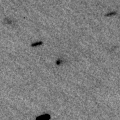
|
Now it is 16.9 mag (Nov. 17, J. Nicolas, C. Rinner, F. Kugel, A. Klotz). It will brighten up to 14 mag in 2017. In 2016, it keeps observable at 16 mag in good condition from winter to spring.
Date(TT) R.A. (2000) Decl. Delta r Elong. m1 Best Time(A, h)
Feb. 6 12 6.33 11 36.9 3.148 3.940 138 16.4 3:05 (180, 43)
Feb. 13 12 4.08 12 5.1 3.069 3.924 145 16.4 2:36 (180, 43)
|
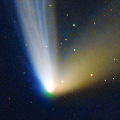
|
It approached to the sun down to 0.3 a.u. on July 6, 2015, and brighted up to 3.9 mag (July 6, Thomas Lehmann). Now it is fading. It has already faded down to 12.9 mag in October (Oct. 3, Chris Wyatt). No observations have been reported since November. In the Southern Hemisphere, it keeps observable until the comet fades out. It will not be observable after this in the Northern Hemisphere.
Date(TT) R.A. (2000) Decl. Delta r Elong. m1 Best Time(A, h)
Feb. 6 19 30.16 -58 4.1 4.261 3.652 46 16.4 3:49 (325, 24)
Feb. 13 19 42.53 -58 24.7 4.293 3.737 50 16.5 3:58 (324, 27)
|

|
Now it is 16.9 mag (Nov. 15, J. Bel). It will brighten up to 14 mag in summer. But it is not observable at the highlight. It keeps observable until March while the comet will be brightening gradually up to 15-16 mag.
Date(TT) R.A. (2000) Decl. Delta r Elong. m1 Best Time(A, h)
Feb. 6 1 21.45 0 50.4 2.500 2.231 62 16.5 20:37 (106, 20)
Feb. 13 1 32.50 2 4.7 2.549 2.208 58 16.4 20:28 (106, 18)
|

|
First return of a periodic comet discovered in 2003. Now it is 15.1 mag (Dec. 17, Space Surveillance Telescope, Atom Site). It will be fading after this, and will be fainter than 18 mag in March. It is observable in excellent condition in the Northern Hemisphere. It locates low in the Southern Hemisphere.
Date(TT) R.A. (2000) Decl. Delta r Elong. m1 Best Time(A, h)
Feb. 6 4 58.25 33 23.0 1.085 1.794 119 16.6 20:37 (171, 21)
Feb. 13 5 8.51 34 54.8 1.170 1.823 115 16.9 20:28 (169, 19)
|
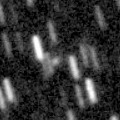
|
Now it is 17.0 mag (Nov. 3, A. Maury, J.-F. Soulier, J.-G. Bosch, T. Noel). It keeps 16.5 mag for a long time in 2016, and it will be observable in excellent condition in the Southern Hemisphere. It is hardly observable in the Northern Hemisphere.
Date(TT) R.A. (2000) Decl. Delta r Elong. m1 Best Time(A, h)
Feb. 6 4 25.36 -59 43.3 3.423 3.474 84 16.6 20:37 ( 21, 62)
Feb. 13 4 9.23 -57 43.9 3.458 3.459 81 16.6 20:28 ( 31, 61)
|
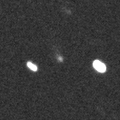
|
Now it is 16.9 mag (Dec. 13, K. Hills). It keeps 16-17 mag for a long time until 2016 autumn. In the Southern Hemisphere, it keeps observable in good condition for a long time. In the Northern Hemisphere, it is observable only until March.
Date(TT) R.A. (2000) Decl. Delta r Elong. m1 Best Time(A, h)
Feb. 6 3 43.25 -28 0.2 2.571 2.730 88 16.6 20:37 ( 97, 64)
Feb. 13 3 40.35 -28 14.9 2.627 2.690 82 16.6 20:28 ( 93, 60)
|
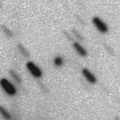
|
Now it is bright as 16.0 mag (Jan. 29, Sandor Szabo). It keeps observable in good condition for a while.
Date(TT) R.A. (2000) Decl. Delta r Elong. m1 Best Time(A, h)
Feb. 6 5 33.70 13 34.4 2.808 3.486 126 16.7 20:37 (178, 41)
Feb. 13 5 34.31 13 3.6 2.905 3.500 119 16.8 20:28 (172, 42)
|

|
Now it is 16.5 mag (Dec. 20, Michael Jager). It must have been observable at 16-17 mag in good condition from summer to autumn in the Northern Hemisphere, but it was not discovered. It will be fading after this, and will be fainter than 18 mag in April.
Date(TT) R.A. (2000) Decl. Delta r Elong. m1 Best Time(A, h)
Feb. 6 12 18.17 33 46.3 1.719 2.517 135 16.7 3:18 (180, 21)
Feb. 13 12 4.29 33 6.6 1.704 2.559 142 16.7 2:36 (180, 22)
|

|
Now it is 16.8 mag (Dec. 18, Space Surveillance Telescope, Atom Site). It is observable at 16.5 mag in excellent condition from December to February. It locates somewhat low in the Southern Hemisphere.
Date(TT) R.A. (2000) Decl. Delta r Elong. m1 Best Time(A, h)
Feb. 6 8 18.02 24 6.4 1.021 1.988 164 16.7 23:14 (180, 31)
Feb. 13 8 15.28 24 44.0 1.058 2.003 156 16.8 22:43 (180, 30)
|
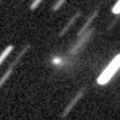
|
Now it is 17.0 mag (Dec. 16, Purple Mountain Observatory). It is observable at 17 mag in good condition in winter.
Date(TT) R.A. (2000) Decl. Delta r Elong. m1 Best Time(A, h)
Feb. 6 7 54.96 24 56.7 1.404 2.351 159 16.9 22:51 (180, 30)
Feb. 13 7 51.17 26 11.3 1.441 2.353 150 17.0 22:19 (180, 29)
|
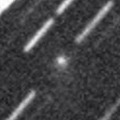
|
Now it is 17.5 mag (Dec. 17, Space Surveillance Telescope, Atom Site). It keeps observable at 17.5 mag in good condition from winter to spring in the Northern Hemispehre. It is observable only until mid February in the Southern Hemisphere.
Date(TT) R.A. (2000) Decl. Delta r Elong. m1 Best Time(A, h)
Feb. 6 6 56.65 36 43.1 1.654 2.512 142 17.1 21:52 (180, 18)
Feb. 13 6 40.06 39 52.6 1.704 2.477 132 17.1 21:08 (180, 15)
|

|
Now it is 17.4 mag (Dec. 11, Purple Mountain Observatory). It will brighten up to 13 mag in summer. But it is not observable around the highlight. In the Southern Hemisphere, it is observable until February when it brightens up to 17 mag. In the Northern Hemisphere, it is observable until April when it brightens up to 16 mag. Sandor Szabo reported it is bright as 16.0 mag visually on Jan. 29.
Date(TT) R.A. (2000) Decl. Delta r Elong. m1 Best Time(A, h)
Feb. 6 2 5.79 11 9.9 3.093 3.024 76 17.3 20:37 (122, 21)
Feb. 13 2 11.22 11 26.2 3.122 2.952 71 17.2 20:28 (120, 19)
|

|
Now it is 18.3 mag (Nov. 15, Hidetaka Sato). It keeps observable at 17 mag in good condition from winter to spring.
Date(TT) R.A. (2000) Decl. Delta r Elong. m1 Best Time(A, h)
Feb. 6 14 53.49 2 10.5 2.215 2.515 95 17.2 3:49 (224, 43)
Feb. 13 14 59.91 2 8.0 2.139 2.522 101 17.2 3:58 (215, 47)
|
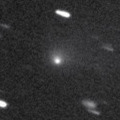
|
It brightened up to 14.5 mag in autumn (Nov. 11, Sandor Szabo). Now it is fading. It has already faded down to 16.7 mag (Dec. 14, L. Elenin). It will be fainter than 18 mag in March.
Date(TT) R.A. (2000) Decl. Delta r Elong. m1 Best Time(A, h)
Feb. 6 2 58.65 10 6.2 2.123 2.322 88 17.2 20:37 (132, 31)
Feb. 13 3 8.31 11 2.6 2.225 2.343 84 17.3 20:28 (131, 29)
|

|
It was observed as bright as 13-14 mag for a long time from 2011 to 2014. Now it is fading. It is observable in excellent condition in the Southern Hemisphere. It locates extremely low in the Northern Hemisphere.
Date(TT) R.A. (2000) Decl. Delta r Elong. m1 Best Time(A, h)
Feb. 6 18 9.62 -30 59.1 9.624 8.952 44 17.2 3:49 (292, 25)
Feb. 13 18 11.14 -31 16.7 9.566 8.985 51 17.2 3:58 (288, 32)
|

|
It brightened up to 8.8 mag in 2015 spring (Apr. 3, Marco Goiato). Now it is fading. It has already faded down to 15.9 mag (Dec. 15, S. Shurpakov). It keeps observable until March when the comet becomes fainter than 18 mag.
Date(TT) R.A. (2000) Decl. Delta r Elong. m1 Best Time(A, h)
Feb. 6 2 14.32 13 18.7 3.044 3.023 79 17.2 20:37 (125, 21)
Feb. 13 2 20.91 13 57.4 3.183 3.062 74 17.4 20:28 (123, 19)
|

|
It has not been observed yet in this apparition. It tends to be brightest after the perihelion passage. It is observable at 17 mag in excellent condition until March in the Northern Hemisphere. It locates low in the Southern Hemisphere.
Date(TT) R.A. (2000) Decl. Delta r Elong. m1 Best Time(A, h)
Feb. 6 5 9.24 40 37.9 0.979 1.717 121 17.3 20:37 (174, 14)
Feb. 13 5 19.35 39 26.3 1.014 1.708 117 17.3 20:28 (172, 15)
|
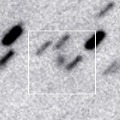
|
Now it is 16.9 mag (Dec. 19, Y. Sugiyama). It keeps 17.5 mag for a long time from 2016 to 2019. It keeps locating near by the equator.
Date(TT) R.A. (2000) Decl. Delta r Elong. m1 Best Time(A, h)
Feb. 6 8 2.88 0 5.5 9.178 10.088 156 17.4 22:58 (180, 55)
Feb. 13 8 1.38 0 22.3 9.197 10.075 151 17.4 22:29 (180, 55)
|
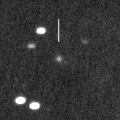
|
Now it is 17.2 mag (Nov. 18, Catalina Sky Survey). Now it is near the aphelion. It is observable at 17 mag in good condition from autumn to winter.
Date(TT) R.A. (2000) Decl. Delta r Elong. m1 Best Time(A, h)
Feb. 6 3 11.01 16 4.7 4.007 4.182 93 17.4 20:37 (139, 28)
Feb. 13 3 13.84 16 24.3 4.107 4.173 86 17.5 20:28 (135, 25)
|
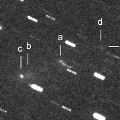
|
First return of a periodic comet which brightened up to 8 mag in major outburst in 2010. It will be observable in excellent condition from winter to spring. However, now it is faint; the fragment A is 17.4 mag (Feb. 5, Toshiyuki Takahashi), the fragment B is 19.2 mag (Feb. 4, C. Rinner, F. Kugel), the fragment C is 17.2 mag (Feb. 5, Toshiyuki Takahashi), the fragment D is 20.0 mag (Feb. 4, C. Rinner, F. Kugel), the fragment E is 19.9 mag (Feb. 3, Mt. Lemmon Survey). It will be 17 mag at best in this apparition. Fragments F-J are also observed in early February.
Date(TT) R.A. (2000) Decl. Delta r Elong. m1 Best Time(A, h)
Feb. 6 8 57.54 36 18.4 0.659 1.619 159 17.6 23:53 (180, 19)
Feb. 13 8 52.58 35 26.6 0.654 1.605 155 17.4 23:20 (180, 20)
|

|
Now it is 17.8 mag (Dec. 18, Hidetaka Sato). It keeps observable at 17.5 mag in good condition until April.
Date(TT) R.A. (2000) Decl. Delta r Elong. m1 Best Time(A, h)
Feb. 6 8 42.18 5 59.2 1.760 2.730 167 17.6 23:37 (180, 49)
Feb. 13 8 34.00 9 44.8 1.744 2.702 162 17.5 23:02 (180, 45)
|
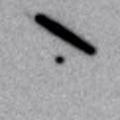
|
Now it is 17.4 mag (Jan. 13, Ken-ichi Kadota). It is observable in good condition in the Northern Hemisphere. It is not observable in the Southern Hemisphere.
Date(TT) R.A. (2000) Decl. Delta r Elong. m1 Best Time(A, h)
Feb. 6 10 57.33 53 28.0 1.638 2.456 137 17.6 1:57 (180, 2)
Feb. 13 10 43.80 53 46.3 1.681 2.504 138 17.7 1:16 (180, 1)
|
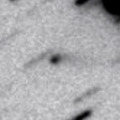
|
Now it is 17.6 mag (Dec. 17, A. Hidas). It keeps 17-18 mag for a long time until 2017 spring.
Date(TT) R.A. (2000) Decl. Delta r Elong. m1 Best Time(A, h)
Feb. 6 6 38.37 -21 48.0 3.339 4.000 126 17.6 21:34 (180, 77)
Feb. 13 6 36.05 -20 0.2 3.352 3.977 122 17.6 21:04 (180, 75)
|
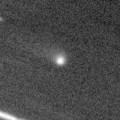
|
It brightened up to 16 mag in early 2015. Now it is 18.1 mag (Dec. 12, ATLAS-HKO, Haleakala). It is observable at 18 mag from winter to spring.
Date(TT) R.A. (2000) Decl. Delta r Elong. m1 Best Time(A, h)
Feb. 6 9 47.20 -24 29.6 5.274 6.052 138 17.6 0:47 (180, 80)
Feb. 13 9 38.62 -24 6.1 5.266 6.076 142 17.6 0:11 (180, 79)
|

|
It has not been observed in this apparition yet. It will brighten up to 16 mag from March to June. It is observable in excellent condition in the Southern Hemisphere. It locates somewhat low in the Northern Hemisphere.
Date(TT) R.A. (2000) Decl. Delta r Elong. m1 Best Time(A, h)
Feb. 6 15 12.53 -7 34.7 1.829 2.057 88 17.8 3:49 (238, 47)
Feb. 13 15 21.67 -9 7.0 1.741 2.046 93 17.6 3:58 (232, 53)
|

|
It will pass the perihelion in 2019. However, it has not been brightening since the discovery in 2010. Now it is 17.6 mag (Dec. 3, D. Buczynski). It keeps observable in excellent condition in the Northern Hemisphere, although it becomes low temporarily in May. It is not observable in the Southern Hemisphere.
Date(TT) R.A. (2000) Decl. Delta r Elong. m1 Best Time(A, h)
Feb. 6 3 8.20 46 57.5 10.416 10.637 100 17.7 20:37 (155, 1)
Feb. 13 3 8.61 46 52.2 10.496 10.614 94 17.7 20:28 (152, 0)
|
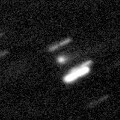
|
It brightened up to 15.2 mag in early 2015 (Feb. 24, Toshiyuki Takahashi). Now it is 17.5 mag (Dec. 6, Catalina Sky Survey). It will be fainter than 18 mag in April.
Date(TT) R.A. (2000) Decl. Delta r Elong. m1 Best Time(A, h)
Feb. 6 11 40.04 -6 16.9 3.986 4.763 137 17.7 2:39 (180, 61)
Feb. 13 11 37.87 -6 9.8 3.937 4.782 145 17.7 2:10 (180, 61)
|
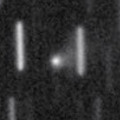
|
Brightening very rapidly, and it keeps brightening even after the perihelion passage. It was very bright as 15.9 mag in December (Dec. 16, Catalina Sky Survey). Probably it is fading now. It keeps observable in excellent condition for a while.
Date(TT) R.A. (2000) Decl. Delta r Elong. m1 Best Time(A, h)
Feb. 6 5 47.86 -10 45.4 1.492 2.183 122 17.8 20:44 (180, 66)
Feb. 13 5 50.62 -9 20.6 1.576 2.217 117 18.0 20:28 (175, 64)
|

|
Very far object. Outburst occured on Feb. 20, 2015, and it brightened up to 15 mag. But it is faint as 18 mag now. It is observable in excellent condition in the Southern Hemisphere. It locates somewhat low in the Northern Hemisphere.
Date(TT) R.A. (2000) Decl. Delta r Elong. m1 Best Time(A, h)
Feb. 6 13 33.39 -26 10.0 8.853 9.150 104 17.8 3:49 (230, 77)
Feb. 13 13 33.40 -26 17.1 8.748 9.152 111 17.8 3:58 (190, 81)
|
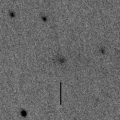
|
Now it is 17.7 mag (Nov. 30, Hidetaka Sato). It was expected to brighten up to 14 mag from winter to summer. But it is much fainter actually. It will be observable in excellent condition in the Southern Hemisphere. It locates low in the Northern Hemisphere.
Date(TT) R.A. (2000) Decl. Delta r Elong. m1 Best Time(A, h)
Feb. 6 15 28.14 -21 41.0 2.180 2.253 81 17.9 3:49 (260, 53)
Feb. 13 15 39.62 -23 13.6 2.115 2.262 85 17.9 3:58 (257, 59)
|

|
Now it is 17.9 mag (Jan. 23, T. Vorobjov). The cometary activity is confirmed recently. It is expected to brighten up to 7 mag in 2017 spring. But it locates somewhat low at the high light.
Date(TT) R.A. (2000) Decl. Delta r Elong. m1 Best Time(A, h)
Feb. 6 11 54.24 -6 21.0 4.937 5.675 134 18.0 2:53 (180, 61)
Feb. 13 11 51.77 -6 11.1 4.796 5.611 142 17.9 2:23 (180, 61)
|

|
It keeps 17-18 mag for a long time since 2013. In the Northern Hemisphere, it is observable at 18 mag in good condition also in this winter. It is not observable in the Southern Hemisphere.
Date(TT) R.A. (2000) Decl. Delta r Elong. m1 Best Time(A, h)
Feb. 6 14 16.59 59 32.1 6.978 7.390 111 17.9 3:49 (191, -6)
Feb. 13 14 10.81 60 28.8 6.968 7.413 113 17.9 3:58 (185, -6)
|
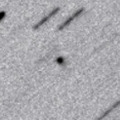
|
It keeps 17.5 mag from 2016 to 2017. It is observable in good condition in the Northern Hemisphere. In the Southern Hemisphere, it locates low in 2016, and it is not observable in 2017.
Date(TT) R.A. (2000) Decl. Delta r Elong. m1 Best Time(A, h)
Feb. 6 17 16.69 13 27.7 6.934 6.593 65 18.0 3:49 (245, 11)
Feb. 13 17 19.75 14 26.8 6.832 6.578 71 17.9 3:58 (239, 16)
|

|
Now it is 19.0 mag (Jan. 10, B. Lutkenhoner). The brightness differs in every apparition. It was not observed in the last apparition. In this apparition, it was expected to be observable at 14-15 mag from winter to spring. But it will be 17 mag at best. It locates extremely low in the Southern Hemisphere.
Date(TT) R.A. (2000) Decl. Delta r Elong. m1 Best Time(A, h)
Feb. 6 23 54.25 2 48.6 1.871 1.340 43 18.3 20:37 ( 95, 1)
Feb. 13 0 15.52 4 20.8 1.858 1.302 41 18.1 20:28 ( 96, 1)
|
|
![]()
 61P/Shajn-Schaldach
61P/Shajn-Schaldach C/2010 S1 ( LINEAR )
C/2010 S1 ( LINEAR ) 88P/Howell
88P/Howell 194P/LINEAR
194P/LINEAR C/2014 B1 ( Schwartz )
C/2014 B1 ( Schwartz ) 74P/Smirnova-Chernykh
74P/Smirnova-Chernykh 331P/2015 Y2 ( Ikeya-Murakami )
331P/2015 Y2 ( Ikeya-Murakami ) C/2015 Y1 ( LINEAR )
C/2015 Y1 ( LINEAR ) 162P/Siding Spring
162P/Siding Spring C/2015 X7 ( ATLAS )
C/2015 X7 ( ATLAS ) C/2013 G9 ( Tenagra )
C/2013 G9 ( Tenagra ) 100P/Hartley 1
100P/Hartley 1 C/2010 U3 ( Boattini )
C/2010 U3 ( Boattini ) 269P/2012 R2 ( Jedicke )
269P/2012 R2 ( Jedicke ) P/2015 Q1 ( Scotti )
P/2015 Q1 ( Scotti ) C/2013 C2 ( Tenagra )
C/2013 C2 ( Tenagra ) C/2014 Y1 ( PanSTARRS )
C/2014 Y1 ( PanSTARRS ) C/2015 ER61 ( PanSTARRS )
C/2015 ER61 ( PanSTARRS ) C/2012 K8 ( Lemmon )
C/2012 K8 ( Lemmon ) C/2014 OE4 ( PanSTARRS )
C/2014 OE4 ( PanSTARRS ) 104P/Kowal 2
104P/Kowal 2![]()
























































